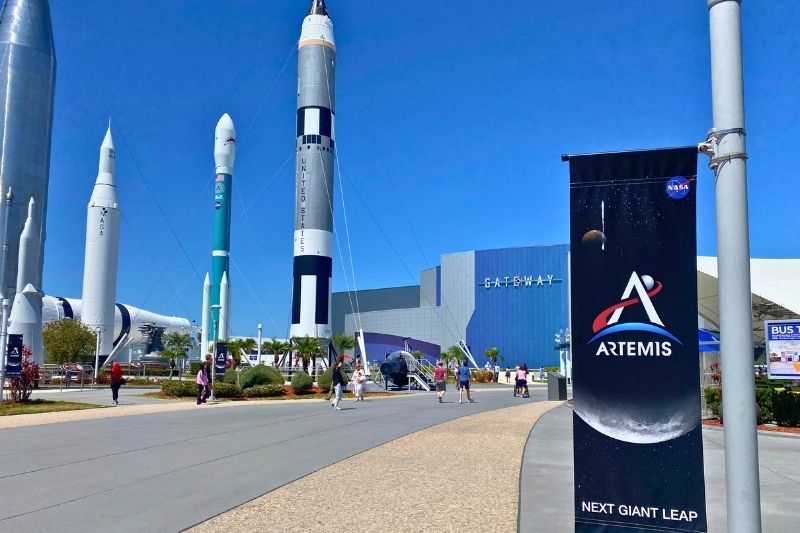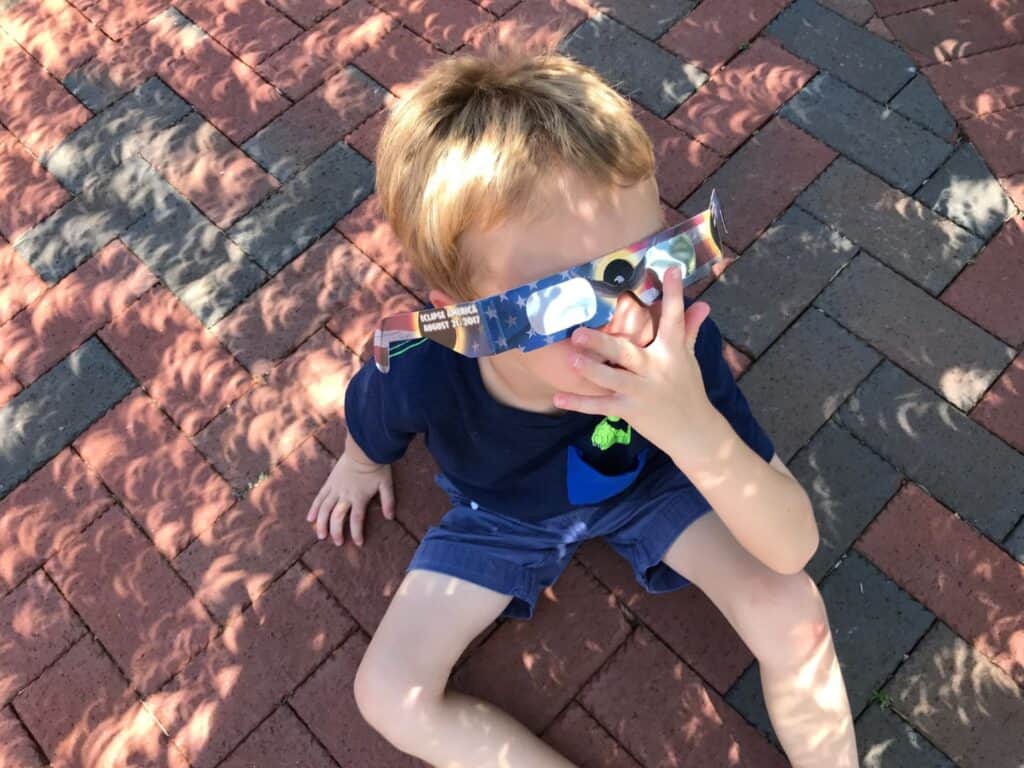How to Enjoy a Solar Eclipse with Your Family in Orlando and Beyond: Events and Tips
Witnessing a solar eclipse with your kids is a special moment to remember. Don’t miss out on this unique event happening on today, April 8, 2024! We’re sharing tips for viewing a solar eclipse together including viewing events in Orlando.
When Is the Next Solar Eclipse?
Today, April 8, 2024 is the Total Solar Eclipse

In Case You’re Interested:
>> Super Fun Family Restaurants
>> Cheap Family Fun
>> Orlando Hotels with Waterparks
Where can it be seen: North America – The path of the eclipse continues from Mexico, entering the United States in Texas, and traveling through Oklahoma, Arkansas, Missouri, Illinois, Kentucky, Indiana, Ohio, Pennsylvania, New York, Vermont, New Hampshire, and Maine. Small parts of Tennessee and Michigan will also experience the total solar eclipse.
Solar Eclipse Viewing Events in Orlando
If viewing from Orlando for the upcoming eclipse, consult the Great American Eclipse website for details. Floridians can expect to see between 50-60% totality, which isn’t bad!
Today’s solar eclipse will reach its peak in Orlando at 3:03 p.m. The eclipse will start in Orlando around 1:47 p.m. and end around 4:13 p.m.
Grab those 3D glasses and enjoy around noon, or check out some local viewing party options:
Orlando Science Center
Eclipse viewing party on Monday, April 8, 2024, arrival times 10am – 4pm
The time frame indicates arrival time only. Once checked in, guests are welcome to enjoy the museum as long as desired within operational hours.
The Orlando Science Center is a great place to visit with kids and they will have a special viewing event! Tickets must be purchased in advance and include protective eyewear.
Orange County Public Library Eclipse Viewing Party
Monday, April 8, 1-4pm
Various Locations
Step outside and view the eclipse in real time and participate in other eclipse activities. Eclipse glasses will be provided while supplies last. Recommended for all ages.
Locations:
- Winter Garden Branch
- South Creek Branch
- Alafaya Branch
- Fairview Shores Branch
- North Orange Branch
- Windermere Branch
- Southwest Branch
- Orlando Public Library
- West Oaks Branch and Genealogy Center
Partial Solar Eclipse and Earth Day Celebration
Monday, April 8, 2-5pm
Kennedy Space Center Visitor Complex
Join fellow enthusiasts and witness nature’s own spectacle as a partial solar eclipse graces the Central Florida skies from 1:48 PM to 4:17 PM. From 2:00 – 5:00 PM, visit the Rocket Garden to pick up your eclipse safety glasses, while supplies last, and enjoy music by roaming DJ Larry.
They will also stream NASA’s live broadcast from various locations in the path of totality on giant screens located in the Rocket Garden.

All activities are included with admission.
Solar Celebration
Monday, April 8, 2:30-4pm
Orange County Regional History Center
The History Center and the Orlando Public Library are hosting a “sun”-sational gathering! Participate in this spectacular solar eclipse viewing party featuring themed games, activities, and hands-on crafts to facilitate a fascinating celestial discovery.
Solar-safe sunglasses and a solar telescope for viewing will be available. Admission to this event is free.
‘Total Eclipse of the Park’ at Bonnet Springs Park
Monday, April 8, 1pm – 3pm
Bonnet Springs Park
Address: 400 Bonnet Springs Boulevard, Lakeland, FL 33815
Head to Bonnet Springs Park in Lakeland for eclipse-themed activities, grab $4 sunglasses, and enjoy the BEST mountain view for full visibility. FREE admission and FREE parking. We recommend arriving early.
And happening before the solar eclipse…
Solar Eclipse Mocktail Lounge
Thursday, April 4, 5-7pm
Orlando Public Library
Attendees will be able to try space inspired mocktails and test their solar eclipse knowledge with a trivia game. registration required. Ages 18 and up.
FREE
Jeni’s Ice Creams
Winter Park Village
Special space-themed flavors
Now – April 8, 2024
Ahead of this natural phenomenon, Jeni’s is taking ice cream lovers on a flight through the galaxy with four cosmic ice creams and edible space dust!
- Nebula Berry – tart like a blueberry and vibrant like a raspberry with an elderflower fragrance
- Cosmic Bloom – a tropical delicacy, citrusy like a mandarin, refreshing like a kiwi, and punchy like passion fruit
- Purple Star Born – reminiscent of Concord grape and puckery-like blackcurrants – intensely juicy
- Supermoon – created from the moon dust that glitters in the sky during a harvest supermoon + tastes like candied violet and marshmallows (returning flavor)
- Space-Themed Topping, Space Dust (NEW) – fizzy popping candy topping from a distant galaxy for a flavor explosion that rocks

Additionally, in local scoop shops, Jeni’s will be offering exclusive branded eclipse glasses, complimentary with purchase beginning the weekend of April 5th. Mark your calendars for eclipse day (April 8), when Space Dust will be free with any Punk Stargonaut flavor purchase!

Seminole County Library Branches – Free Solar Eclipse Glasses
Monday, April 1-Monday, April 8 (while supplies last)
All Seminole County libraries
Starting Monday, April 1, head to your nearest Seminole County library to grab a pair of free solar eclipse glasses. The glasses are safe for direct solar viewing. Two per household, while supplies last.
How to Find Out About Upcoming Solar Eclipses
The best way to find out when there will be a solar eclipse is to check out the Future Eclipses page from NASA. This website shares details on the upcoming eclipses for the next two years, while other sites go so far as listing out the next ten years’ worth of eclipses!
In my opinion, NASA is the best for browsing details about the next few (the site currently lists eclipses happening through 2025) because of its trustworthiness and its cool related features on the page, like how to take photos of the solar eclipse and articles about the impact of a solar eclipse on wildlife and atmospheric changes.
Learning Opportunities for Your Children
Seeing a solar eclipse is a pretty unique experience! A few years ago the shelves and even Amazon stock were empty after a run on solar eclipse glasses here in Florida. Everyone wanted to be a part of it, to experience something not commonly seen in certain corners of the globe.

Parenting pro-tip: check out the shadows on the ground during a solar eclipse for a unique curvy shape. You can also use a collander with circular holes to see the special arched shadows. Place it on the ground on top of a white board or paper so you can see the shadows.
Get your kids excited about this once-every-now-and-then opportunity by studying in advance. Learn about the sun on a really neat website, also made by NASA, called the Space Place, a special area of their website made for children to explore and learn more about the solar system. The site offers games, activities, craft ideas, trivia, and more to encourage your littles to understand the sun’s power.
By the way, a visit to Kennedy Space Center is a must-do with your kids – it’s such a fun experience.
Types of Solar Eclipses
In its simplest description, a solar eclipse is when the moon goes between the sun and Earth, blocking the sun from shining.
NASA has generated some great information on this topic, as well. Visit their website to learn about the types of solar eclipses, which include four types:
- Total eclipse: This is when the moon fully blocks the sun, creating sudden darkness like dusk.
- Annular eclipse: This is when the moon is farthest from the earth, making it small enough to not quite block the sun. The sun will appear as a gold ring around a black moon, often called a ‘ring of fire’.
- Partial eclipse: This type of eclipse creates a crescent-shaped block of the sun, due to a misalignment of the sun, moon, and earth.
- Hybrid eclipse: This happens as annular and total eclipses pass along the earth’s curved surface, creating a hybrid of the above.
Traveling to see a solar eclipse
If you are considering traveling to see a solar eclipse, it’s going to be a memorable trip. My husband did this several years ago with friends and they were not alone! Thousands of cars traveled north on I-95, heading to the best spot for “full totality” in the “path of totality”.
Totality is when the sun is fully obstructed by the eclipse, so the path of totality is the band of the earth that can see the full eclipse.

In many cases, in Florida, we will only see a percentage of the eclipse, so traveling is a great idea for the full experience.
If you do travel, consider booking your hotel as far in advance as possible, as the hotels will likely be full of gawkers looking to do exactly the same as you!
Plan for the timing of the eclipse. My husband said he ended up having to pull off the road at a McDonald’s to catch the big moment, because they weren’t going to make it in time. Get there early and as it gets closer, use NASA’s website to learn about the approximate timing of the eclipse in that area.
For the upcoming eclipse on April 8, 2024, visit this site to learn more about the path of totality, the percentage of visibility in your area, and what time of day to expect the eclipse.
Be sure to arrive at the viewing destination with ample time to relax, find a nice field or park to enjoy the eclipse, and remember safety first!
Eyewear and Safety
When it comes to staring at the sun, we’ve all been told growing up not to do it, for obvious reasons. “Your eyes will burn out!” seems like a pretty good reason to me, but in any case for eclipses we have to be extra careful because you’ll likely be staring at the sun for prolonged periods.
In this case, sunglasses won’t cut it. You need special eyewear called solar eclipse glasses. They look like paper 3D movie glasses and can be purchased online individually or in bulk.
Be sure to wear them at all times during the eclipse, when you are looking toward the sky.
If you are a crafty household, you can make your own eclipse viewing box. A few years back everyone was making them from cereal boxes, but this is a great tutorial for something a bit sturdier.

Lastly, it’s always good practice to wear UV protection clothing and sunblock, and a good hat to keep the sun off your face.

